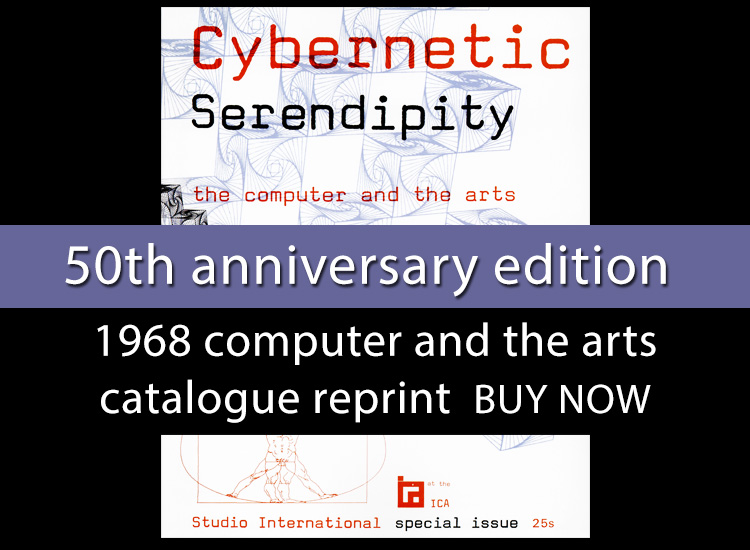
Editor: Jasia Reichardt
Publisher: Studio International Foundation 2018
Content: 104 pages, mono
Language: English
ISBN: 9781948764001 (Softcover)
Dimensions: 303 x 244 x 8 mm (12.0 x 9 5/8 x 5/16 in)
Available to buy from Art Data
In July 1968, a special issue of Studio International was published, Cybernetic Serendipity: The Computer and the Arts, which was realised in relation to the Cybernetic Serendipity exhibition held at London’s Institute of Contemporary Art from August to October of the same year. The show drew attention to the inventive ways that artists, scientists and technology experts were working together to make computer-generated graphics, animations and music, as well as cybernetic machines and environments. The idea was that artistic forms could be, and were, spawned by technology. The exhibition was curated by Jasia Reichardt, in collaboration with Mark Dowson (technological adviser) and Peter Schmidt (musical adviser) and designed by Franciszka Themerson.
Contents
Introduction and acknowledgements
Contributors
Norbert Wiener on cybernetics
Notes on cybernetics and digital computers by Mark Dowson
SAM by Stafford Beer
Highlights of the history and technology of computers from 1890 to the present
Glossary
Bibliography
The computer and music:
Coordinate expansion by Joseph Schillinger
Computers and music by Dr JR Pierce
Extract from notes on ‘Mikrophonie I’ by Karlheinz Stockhausen
Composition with computers by Herbert Brun
Extracts from: Computer music experiences 1961-4 by James Tenney
Computer music by Lejaren A Hiller, Jr.
Extract from ‘A year from monday’ by John Cage
The computer in musical composition by Gerald Strang
Two electronic music computer projects in Britain by Peter Zinovieff
Music from paper tape by T. H. O'Beirne
Computer projects:
Five screens with computer by Gustav Metzger
Computer structures by Johan Severtson
Computer dance:
Computer-programmed choreography
Machines and environments:
The colloquy of mobiles by Gordon Pask
Analogue feedback projection system by John Lifton
Sidebands 1968 by Hugh Riddle and Anthony Pritchett
Carm-0-Matic by Eugenio Carmi
Sound-activated mobile by Edward lhnatowicz
On the human predicament by Bruce Lacey
Mechanical patternmaker by Roy E. Allen
Five-year guaranty by Norman Bauman
Simulated synasthesia by Roger Dainton
Cybernetic light tower
The Honeywell Emett ‘Forget-me-not’ (peripheral pachyderm computer)
The Tychotech by John Cohen
The pendulum harmonograph: a drawing machine by Ivan Moscovich
Limitations and general design features of a pendulum drawing machine by John Ravilious
The Henry drawing computer by D. P. Henry
Amor-Voluptas-Pulchritudo 1966/68 by Ken Cox
Cybernetic introspective pattern-classifier by Christopher Evans
Combinatorial geometry by Raymond Connor
Computer poems and texts:
Computer texts by Marc Adrian
Computerized Japanese haiku
Computer poetry from CLRU by Robin McKinnon Wood and Margaret Masterman
Tape Mark I by Nanni Balestrini
A sheet from ‘The house’, a computer poem by Alison Knowles and James Tenney
Note on simulated computer poems by Edwin Morgan
Automatic sentence generation by Jean A. Baudot
Computer texts or high-entropy essays by E. Mendoza
Computer paintings:
Computer paintings of Lowell Nesbitt by Henry Martin
Computer films:
Permutations by John H. Whitney
Computer-animated movies by Kenneth C. Knowlton
An architectural project:
Indeterminate dimensions in architecture by John Weeks
Computer graphics:
Computer art by Jasia Reichardt
Experiments with Data Processing
How the hexagonalized pictures were formed by Robert Dick
A subjective comparison of Piet Mondrian’s ‘Compostition with lines’ 1917 by A. Michael Noll
Computer Technique Group from Japan
Notes on the programming of computer graphics by Frieder Nake
Programming stochastic computer graphics by Georg Nees
Bugs and patterns by Donald K. Robbins and Leigh Hendricks
An interview with Charles Csuri by Arthur Efland
How to draw a ball by Alan Parkin
Computer-generated pictures by L. D. Harmon and K. C. Knowlton
Boeing computer graphics
Computart panelling by Robert Parslow and Michael Pitteway
Calcomp plotting system
Computer-generated graphics by Maughan S. Mason
Computer pictures by Andrew Colin
Geometric patterns
Mathematically-defined surfaces by A. R. Forrest
Cubic interpolations by Sam Schmitt
Isometric view of neutron distribution by D. J. Dileonardo
Shift-register derived patterns by D. H. Green
Oscillons (electronic abstractions) by Ben F. Laposky
Cydac images by Mortimer L. Mendelsohn, Brian H. Myall, Judith M. S. Prewitt , Benson H. Perry, and Thomas J. Conway
Index